User:Rygel, M.C./SedimentaryRock Sandbox
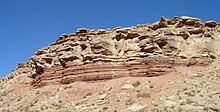
Sedimentary rock is a type of rock that is formed by sedimentation of material at the Earth's surface and within bodies of water. Sedimentation is the collective name for processes that cause mineral and/or organic particles (detritus) to settle and accumulate or minerals to precipitate from a solution. Particles that form a sedimentary rock by accumulating are called sediment. Before being deposited, sediment was formed by weathering and erosion in a source area, and then transported to the place of deposition by water, wind, mass movement or glaciers which are called agents of denudation.
The sedimentary rock cover of the continents of the Earth's crust is extensive, but the total contribution of sedimentary rocks is estimated to be only 5% of the total volume of the crust. Sedimentary rocks are only a thin veneer over a crust consisting mainly of igneous and metamorphic rocks.
Sedimentary rocks are deposited in layers as strata, forming a structure called bedding. The study of sedimentary rocks and rock strata provides information about the subsurface that is useful for civil engineering, for example in the construction of roads, houses, tunnels, canals or other constructions. Sedimentary rocks are also important sources of natural resources like coal, fossil fuels, drinking water or ores.
The study of the sequence of sedimentary rock strata is the main source for scientific knowledge about the Earth's history, including palaeogeography, paleoclimatology and the history of life.
The scientific discipline that studies the properties and origin of sedimentary rocks is called sedimentology. Sedimentology is both part of geology and physical geography and overlaps partly with other disciplines in the Earth sciences, such as pedology, geomorphology, geochemistry or structural geology.
Formation of Sedimentary Rocks
[edit]Sedimentary rocks are formed when sediment is deposited out of air, ice, wind, gravity, or water flows carrying the particles in suspension. This sediment is often formed when weathering and erosion break down a rock into loose material in a source area. The material is then transported from the source area to the deposition area. The type of sediment transported depends on the geology of the hinterland (the source area of the sediment). However, some sedimentary rocks, like evaporites, are composed of material that formed at the place of deposition. The nature of a sedimentary rock therefore not only depends on sediment supply, but also on the sedimentary depositional environment in which it formed.
Genetic Classification Schemes
[edit]Based on the processes responsible for their formation, sedimentary rocks can be subdivided into four groups: clastic sedimentary rocks, biochemical (or biogenic) sedimentary rocks, chemical sedimentary rocks and a fourth category for "other" sedimentary rocks formed by impacts, volcanism, and other minor processes.
Clastic Sedimentary Rocks
[edit]
Clastic sedimentary rocks are composed of silicate minerals and rock fragments that were transported by moving fluids (as bed load, suspended load, or by sediment gravity flows) and were deposited when these fluids came to rest. Clastic rocks are composed largely of quartz, feldspar, rock (lithic) fragments, clay minerals, and mica; numerous other minerals may be present as accessories and may be important locally.
Clastic sediment, and thus clastic sedimentary rocks, are subdivided according to the dominant particle size (diameter). Most geologists use the Udden-Wentworth grain size scale and divide unconsolidated sediment into three fractions: gravel (>2 mm diameter), sand (1/16 to 2 mm diameter), and mud (clay is <1/256 mm and silt is between 1/16 and 1/256 mm). The classification of clastic sedimentary rocks parallels this scheme; conglomerates and breccias are made mostly of gravel, sandstones are made mostly of sand, and mudrocks are made mostly of mud. This tripartite subdivision is mirrored by the broad categories of rudites, arenites, and lutites, respectively, in older literature.
Subdivision of these three broad categories is based on differences in clast shape (conglomerates and breccias), composition (sandstones), grain size and/or texture (mudrocks).
Conglomerates and Breccias
[edit]Conglomerates are dominantly composed of rounded gravel and breccias are composed of dominantly angular gravel.
Sandstones
[edit]Sandstone classification schemes vary widely, but most geologists have adopted the Dott scheme [1], which uses the relative abundance of quartz, feldspar, and lithic framework grains and the abundance of muddy matrix between these larger grains.
- Composition of framework grains
- The relative abundance of sand-sized framework grains determines the first word in a sandstone name. For naming purposes, the abundance of framework grains is normalized to quartz, feldspar, and lithic fragments formed from other rocks. These are the three most abundant components of [[sandstone|sandstones]; all other minerals are considered accessories and not used in the naming of the rock, regardless of abundance.
- Quartz sandstones have >90% quartz grains
- Feldspathic sandstones have <90% quartz grains and more feldspar grains than lithic grains
- Lithic sandstones have <90% quartz grains and more lithic grains than feldspar grains
- Abundance of muddy matrix between sand grains
- When sand-sized particles are deposited, the space between the sand grains either remains open or is filled with mud (silt and/or clay sized particle).
- "Clean" sandstones with open pore space (that may later be filled with cement) are called arenites
- Muddy sandstones with abundant (>10%) muddy matrix are called arenites.
- When sand-sized particles are deposited, the space between the sand grains either remains open or is filled with mud (silt and/or clay sized particle).
Six sandstone names are possible using descriptors for grain composition (quartz-, feldspathic-, and lithic-) and amount of matrix (wacke or arenite). For example, a quartz arenite would be composed of mostly (>90%) quartz grains and have little/no clayey matrix between the grains, a lithic wacke would have abundant lithic grains (<90% quartz, remainder would have more lithics than feldspar) and abundant muddy matrix, etc.
Although the Dott classification scheme[1]. is widely used by sedimentologists, common names like greywacke, arkose, and quartz sandstone are still widely used by nonspecialists and in popular literature.
Mudrocks
[edit]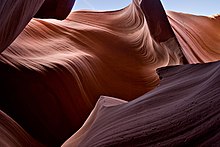
Mudrocks are sedimentary rocks composed of at least 50% silt- and clay-sized particles. These relatively fine-grained particles are commonly transported as suspended particles by turbulent flow in water or air, and deposited as the flow calms and the particles settle out of suspension.
Most authors presently use the term "mudrock" to refer to all rocks composed dominantly of mud [2][3][4][5]. Mudrocks can be divided into siltstones (composed dominantly of silt-sized particles), mudstones (subequal mixture of silt- and clay-sized particles), and claystones (composed mostly of clay-sized particles)[2][3]. Most authors use "shale" is a term for a fissile mudrock (regardless of grain size), although some older literature uses the term "shale" as a synonym for mudrock.
Biochemical Sedimentary Rocks
[edit]
Biochemical sedimentary rocks are created when organisms use materials dissolved in air or water to build their tissue. Examples include:
- Most types of limestone are formed from the calcareous skeletons of organisms such as corals, mollusks, and foraminifera.
- Coal which forms as plants remove carbon from the atmosphere and combine ith with other elements to build their tissue.
- Deposits of chert formed from the accumulation of siliceous skeletons from microscopic organisms such as radiolaria and diatoms.
Chemical Sedimentary Rocks
[edit]Chemical sedimentary rocks form when minerals in solution become supersaturated and inorganically precipitate. Common chemical sedimentary rocks include oolitic limestone and rocks composed of evaporite minerals such as halite (rock salt), sylvite, barite and gypsum.
"Other" Sedimentary Rocks
[edit]This fourth miscellaneous category includes rocks formed by pyroclastic flows, impact breccias, volcanic breccias, and other relatively uncommon processes.
Compositional Classification Schemes
[edit]Alternately, sedimentary rocks can be subdivided into compositional groups based on their mineralogy:
- Siliciclastic sedimentary rocks, as described above, dominantly composed of silicate minerals. The sediment that makes up these rocks was transported as bed load, suspended load, or by sediment gravity flows. Siliciclastic sedimentary rocks are subdivided into conglomerates and breccias, sandstone, and mudrocks.
- Carbonate sedimentary rocks are composed of calcite (rhombohedral CaCO3), aragonite (orthorhombic CaCO3), dolomite (CaMg(CO3)2), and other carbonate minerals based on the CO32- ion. Common examples include limestone and dolostone.
- Evaporite sedimentary rocks are composed of minerals formed from the evaporation of water. The most common evaporite minerals are carbonates (calcite and others based on CO32-), chlorides (halite and others built on Cl-), and sulfates (gypsum and others built on SO42-). Evaporite rocks commonly include abundant halite (rock salt), gypsum, and anhydrite.
- Organic-rich sedimentary rocks have significant amounts of organic material, generally in excess of 5% total organic carbon. Common examples include coal, oil shale, and other sedimentary rocks that act as reservoirs for liquid hydrocarbons and natural gas.
- Siliceous sedimentary rocks are almost entirely composed of silica (SiO2), typically as chert, opal, chalcedony or other microcrystalline forms.
- Iron-rich sedimentary rocks are composed of >15% iron; the most common forms are banded iron formations and ironstones[3]
- Phosphatic sedimentary rocks are composed of phosphate minerals and contain more than 6.5% phosphorus; examples include deposits of phosphate nodules, bone beds, and phosphatic mudrocks[4]
Diagenesis
[edit]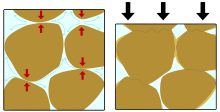
The term diagenesis is used to describe all the chemical, physical, and biological changes, including cementation, undergone by a sediment after its initial deposition, exclusive of surface weathering. Some of these processes cause the sediment to consolidate: a compact, solid substance forms out of loose material. Young sedimentary rocks, especially those of Quaternary age (the most recent period of the geologic time scale) are often still unconsolidated. As sediment deposition builds up, the overburden (or lithostatic) pressure rises and a process known as lithification takes place.
Sedimentary rocks are often saturated with seawater or groundwater, in which minerals can dissolve or from which minerals can precipitate. Precipitating minerals reduce the pore space in a rock, a process called cementation. Due to the decrease in pore space, the original connate fluids are expelled. The precipitated minerals form a cement and make the rock more compact and competent. In this way, loose clasts in a sedimentary rock can become "glued" together.
When sedimentation continues, an older rock layer becomes buried deeper as a result. The lithostatic pressure in the rock increases due to the weight of the overlying sediment. This causes compaction, a process in which grains mechanical reorganize. Compaction is, for example, an important diagenetic process in clay, which can initially consist of 60% water. During compaction, this interstitial water is pressed out of. Compaction can also be due to chemical processes, such as pressure solution. Pressure solution means material is going into solution at areas under high stress. The dissolved material precipitates again in open pore spaces, which menas there is a nett flow of material into the pores. However, in some cases a certain mineral dissolves and not precipitate again. This process is called leaching and increases pore space in the rock.
Some biochemical processes, like the activity of bacteria, can affect minerals in a rock and are therefore seen as part of diagenesis. Fungi and plants (by their roots) and various other organisms that live beneath the surface can also influence diagenesis.
Burial of rocks due to ongoing sedimentation leads to increased pressure and temperature, which stimulates certain chemical reactions. An example is the reactions by which organic material becomes lignite or coal. When temperature and pressure increase still further, the realm of diagenesis makes way for metamorphism, the process that forms metamorphic rock.
Properties
[edit]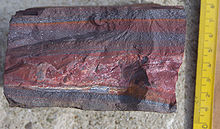
Color
[edit]The color of a sedimentary rock is often mostly determined by iron, an element with two major oxides: iron(II) oxide and iron(III) oxide. Iron(II) oxide only forms under anoxic circumstances and gives the rock a grey or greenish colour. Iron(III) oxide is often in the form of the mineral hematite and gives the rock a reddish to brownish colour. In arid continental climates rocks are in direct contact with the atmosphere, and oxidation is an important process, giving the rock a red or orange colour. Thick sequences of red sedimentary rocks formed in arid climates are called red beds. However, a red colour does not necessarily mean the rock formed in a continental environment or arid climate.[6]
The presence of organic material can colour a rock black or grey. Organic material is in nature formed from dead organisms, mostly plants. Normally, such material eventually decays by oxidation or bacterial activity. Under anoxic circumstances, however, organic material cannot decay and becomes a dark sediment, rich in organic material. This, can for example, occur at the bottom of deep seas and lakes. There is little water current in such environments, so oxygen from surface water is not brought down, and the deposited sediment is normally a fine dark clay. Dark rocks rich in organic material are therefore often shales.[7]
Texture
[edit]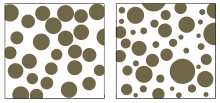
The size, form and orientation of clasts or minerals in a rock is called its texture. The texture is a small-scale property of a rock, but determined many of its large-scale properties, such as the density, porosity or permeabililty.[8]
Clastic rocks have a 'clastic texture', which means they consist of clasts. The 3D orientation of these clasts is called the fabric of the rock. Between the clasts the rock can be composed of a matrix or a cement (the latter can consist of crystals of one or more precipitated minerals). The size and form of clasts can be used to determine the velocity and direction of current in the sedimentary environment where the rock was formed; fine, calcareous mud only settles in quiet water, while gravel and larger clasts are only deposited by rapidly moving water.[9] The grain size of a rock is usually expressed with the Wentworth scale, though alternative scales are used sometimes. The grain size can be expressed as a diameter or a volume, and is always an average value - a rock is composed of clasts with different sizes. The statistical distribution of grain sizes is different for different rock types and is described in a property called the sorting of the rock. When all clasts are more or less of the same size, the rock is called 'well-sorted', when there is a large spread in grain size, the rock is called 'poorly sorted'.[10]

The form of clasts can reflect the origin of the rock.
Coquina, a rock composed of clasts of broken shells, can only form in energetic water. The form of a clast can be described by using four parameters:[11]
- Surface texture describes the amount of small-scale relief of the surface of a grain that is too small to influence the general shape.
- rounding describes the general smoothness of the shape of a grain.
- 'Sphericity' describes the degree to which the grain approaches a sphere.
- 'Grain form' describes the three dimensional shape of the grain.
Chemical sedimentary rocks have a non-clastic texture, consisting entirely of crystals. To describe such a texture only the average size of the crystals and the fabric are necessary.
Mineralogy
[edit]Most sedimentary rocks contain either quartz (especially siliciclastic rocks) or calcite (especially carbonate rocks). In contrast with igneous and metamorphic rocks, a sedimentary rocks usually contains very few different major minerals. However, the origin of the minerals in a sedimentary rock is often more complex than those in an igneous rock. Minerals in a sedimentary rock can have formed by precipitation during sedimentation or diagenesis. In the second case, the mineral precipitate can have grown over an older generation of cement.[12] A complex diagenetic history can be studied by optical mineralogy, using a petrographic microscope.
Carbonate rocks dominantly consist of carbonate minerals like calcite, aragonite or dolomite. Both cement and clasts (including fossils and ooids) of a carbonate rock can consist of carbonate minerals. The mineralogy of a clastic rock is determined by the supplied material from the source area, the manner of transport to the place of deposition and the stability of a particular mineral. The stability of the major rock forming minerals (their resistance to weathering) is expressed by Bowen's reaction series. In this series, quartz is most stable, followed by feldspar, micas, and other less stable minerals that are only present when little weathering has occurred.[13] The amount of weathering depends mainly on the distance to the source area, the local climate and the time it took for the sediment to be transported there. In most sedimentary rocks, mica, feldspar and less stable minerals have reacted to clay minerals like kaolinite, illite or smectite.
Fossils
[edit]
Sedimentary rocks are the only type of rock that can contain fossils, the remains or imprints of dead organisms. In nature, dead organisms are usually quickly removed by scavengers, bacteria, rotting and erosion. In some exceptional circumstances a carcass is fossilized because these natural processes are unable to work. The chance of fossilisation is higher when the sedimentation rate is high (so that a carcass is quickly buried), in anoxic environments (where little bacterial activity exists) or when the organism had a particularly hard skeleton. Larger, well-preserved fossils are relatively rare. Most sedimentary rocks contains fossils, though with many the fact only becomes apparent when studied under a microscope (microfossils) or with a loupe.
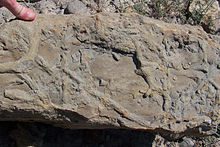
Fossils can both be the direct remains or imprints of organisms and their skeletons. Most commonly preserved are the harder parts of organisms such as bones, shells, woody tissue of plants. Soft tissue has a much smaller chance of being preserved and fossilized and soft tissue of animals older than 40 million years is very rare.[14] Imprints of organisms made while still alive are called trace fossils. Examples are burrows, foot prints, etc.
Being part of a sedimentary rock, fossils undergo the same diagenetic processes as the rock. A shell consisting of calcite can for example dissolve, while a cement of silica then fills the cavity. In the same way, precipitating minerals can fill cavities formerly occupied by blood vessels, vascular tissue or other soft tissues. This preserves the form of the organism but changes the chemical composition, a process called permineralisation.[15] The most common minerals in permineralisation cements are carbonates (especially calcite), forms of amorphous silica (chalcedony, flint, chert) and pyrite. In the case of silica cements, the process is called lithification.
At high pressure and temperature, the organic material of a dead organism undergoes chemical reactions in which volatiles like water and carbon dioxide are expulsed. The fossil, in the end, consists of a thin layer of pure carbon or its mineralized form, graphite. This form of fossilisation is called carbonisation. It is particularly important for plant fossils.[16] The same process is responsible for the formation of fossil fuels like lignite or coal.
Primary sedimentary structures
[edit]


Structures in sedimentary rocks can be divided in 'primary' structures (formed during deposition) and 'secondary' structures (formed after deposition). Unlike textures, structures are always large-scale features that can easily be studied in the field. Sedimentary structures can tell something about the sedimentary environment or can serve to tell which side originally faced up where tectonics have tilted or overturned sedimentary layers.
Sedimentary rocks are laid down in layers called beds or strata. A bed is defined as a layer of rock that has a uniform lithology and texture. Beds form by the deposition of layers of sediment on top of each other. The sequence of beds that characterizes sedimentary rocks is called bedding.[17] Single beds can be a couple of centimetres to several meters thick. Finer, less pronounced layers are called laminae and the structure it forms in a rock is called lamination. Laminae are usually less than a few centimetres thick.[18] Though bedding and lamination are often originally horizontal in nature, this is not always the case. In some environments, beds are deposited at a (usually small) angle. Sometimes multiple sets of layers with different orientations exist in the same rock, a structure called cross-bedding.[19] Cross-bedding forms when small-scale erosion occurs during deposition, cutting off part of the beds. Newer beds then form at an angle to older ones.
The opposite of cross-bedding is parallel lamination, where all sedimentary layering is parallel.[20] With laminations, differences are generally caused by cyclic changes in the sediment supply, caused for example by seasonal changes in rainfall, temperature or biochemical activity. Laminae that represent seasonal changes (like tree rings) are called varves. Some rocks have no lamination at all, their structural character is called massive bedding.
Graded bedding is a structure where beds with a smaller grain size occur on top of beds with larger grains. This structure forms when fast flowing water stops flowing. Larger, heavier clasts in suspension settle first, then smaller clasts. Though graded bedding can form in many different environments, it is characteristic for turbidity currents.[21]
The bedform (the surface of a particular bed) can be indicative for a particular sedimentary environment too. Examples of bed forms are sole markings and ripple marks. Sole markings, such as tool marks and flute casts, are grove dug into a sedimentary layer that are preserved. These are often elongated structures and can be used to establish the direction of the flow during deposition.[22]
Ripple marks also form in flowing water. There are two types: asymmetric wave ripples and symmetric current ripples. Environments where the current is in one direction, such as rivers, produce asymmetric ripples. The longer flank of such ripples is oriented opposite to the direction of the current.[23] Wave ripples occur in environments where currents occur in all directions, such as tidal flats.
Another type of bed form are mud cracks, caused by the dehydration of sediment that occasionally comes above the water surface. Such structures are commonly found at tidal flats or point bars along rivers.
Secondary sedimentary structures
[edit]Secondary sedimentary structures are structures in sedimentary rocks which formed after deposition. Such structures form by chemical, physical and biological processes inside the sediment. They can be indicators for circumstances after deposition. Some can be used as way up criteria.
Organic presence in a sediment can leave more traces than just fossils. Preserved tracks and burrows are examples of trace fossils (also called ichnofossils).[24] Some trace fossils such as paw prints of dinosaurs or early humans can capture human imagination, but such traces are relatively rare. Most trace fossils are burrows of molluscs or arthropods. This burrowing is called bioturbation by sedimentologists. It can be a valuable indicator of the biological and ecological environment after the sediment was deposited. On the other hand, the burrowing activity of organisms can destroy other (primary) structures in the sediment, making a reconstruction more difficult.
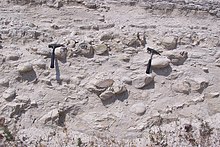
Secondary structures can also have been formed by diagenesis or the formation of a soil (pedogenesis) when a sediment is exposed above the water level. An example of a diagenetic structure common in carbonate rocks is a stylolite.[25] Stylolites are iregular planes were material was dissolved into the pore fluids in the rock. The result of precipitation of a certain chemical species can be colouring and staining of the rock, or the formation of concretions. Concretions are roughly concentric bodies with a different composition from the host rock. Their formation can be the result of localized precipitation due to small differences in composition or porosity of the host rock, such as around fossils, inside burrows or around plant roots.[26] In carbonate rocks such as limestone or chalk, chert or flint concretions are common, while terrestrial sandstones can have iron concretions. Calcite concretions in clay are called septarian concretions.
After deposition, physical processes can deform the sediment, forming a third class of secondary structures. Density contrasts between different sedimentary layers, such as between sand and clay, can result in flame structures or load casts, formed by inverted diapirism.[27] The diapirism causes the denser upper layer to sink into the other layer. Sometimes, density contrast can result or grow when one of the lithologies dehydrates. Clay can be easily compressed as a result of dehydration, while sand retains the same volume and becomes relatively less dense. On the other hand, when the pore fluid pressure in a sand layer surpasses a critical point the sand can flow through overlying clay layers, forming discordant bodies of sedimentary rock called sedimentary dykes (the same process can form mud volcanoes on the surface).
A sedimentary dyke can also be formed in a cold climate where the soil is permanently frozen during a large part of the year. Frost weathering can form cracks in the soil that fill with rubble from above. Such structures can be used as climate indicators as well as way up structures.[28]
Density contrasts can also cause small-scale faulting, even while sedimentation goes on (syn-sedimentary faulting).[29] Such faulting can also occur when large masses of non-lithified sediment are deposited on a slope, such as at the front side of a delta or the continental slope. Instabilities in such sediments can result in slumping. The resulting structures in the rock are syn-sedimentary folds and faults, which can be difficult to distinguish from folds and faults formed by tectonic forces in lithified rocks.
Sedimentary environments
[edit]The setting in which a sedimentary rock forms is called the sedimentary environment. Every environment has a characteristic combination of geologic processes and circumstances. The type of sediment that is deposited is not only dependent on the sediment that is transported to a place, but also on the environment itself.[30]
A marine environment means the rock was formed in a sea or ocean. Often, a distinction is made between deep and shallow marine environments. Deep marine usually refers to environments more than 200 m below the water surface. Shallow marine environments exist adjacent to coastlines and can extend out to the boundaries of the continental shelf. The water in such environments has a generally higher energy than that in deep environments, because of wave activity. This means coarser sediment particles can be transported and the deposited sediment can be coarser than in deep environments. When the available sediment is transported from the continent, an alternation of sand, clay and silt is deposited. When the continent is far away, the amount of such sediment brought in may be small, and biochemical processes dominate the type of rock that forms. Especially in warm climates, shallow marine environments far offshore mainly see deposition of carbonate rocks. The shallow, warm water is an ideal habitat for many small organisms that build carbonate skeletons. When these organisms die their skeletons sink to the bottom, forming a thick layer of calcareous mud that may lithify into limestone. Warm shallow marine environments also are ideal environments for coral reefs, where the sediment consists mainly of the calcareous skeletons of larger organisms.[31]
In deep marine environments, the water current over the sea bottom is small. Only fine particles can be transported to such places. Typically sediments depositing on the ocean floor are fine clay or small skeletons of micro-organisms. At 4 km depth, the solubility of carbonates increases dramatically (the depth zone where this happens is called the lysocline). Calcareous sediment that sinks below the lysocline dissolve, so no limestone can be formed below this depth. Skeletons of micro-organisms formed of silica (such as radiolarians) still deposit though. An example of a rock formed out of silica skeletons is radiolarite. When the bottom of the sea has a small inclination, for example at the continental slopes, the sedimentary cover can become unstable, causing turbidity currents. Turbidity currents are sudden disturbances of the normally quite deep marine environment and can cause the geologically speaking instantaneous deposition of large amounts of sediment, such as sand and silt. The rock sequence formed by a turbidity current is called a turbidite.[32]
The coast is an environment dominated by wave action. At the beach, dominantly coarse sediment like sand or gravel is deposited, often mingled with shell fragments. Tidal flats and shoals are places that sometimes dry out because of the tide. They are often cross-cut by gullies, where the current is strong and the grain size of the deposited sediment is larger. Where along a coast (either the coast of a sea or a lake) rivers enter the body of water, deltas can form. These are large accumulations of sediment transported from the continent to places in front of the mouth of the river. Deltas are dominantly composed of clastic sediment.
A sedimentary rock formed on the land has a continental sedimentary environment. Examples of continental environments are lagoons, lakes, swamps, floodplains and alluvial fans. In the quiet water of swamps, lakes and lagoons, fine sediment is deposited, mingled with organic material from dead plants and animals. In rivers, the energy of the water is much higher and the transported material consists of clastic sediment. Besides transport by water, sediment can in continental environments also be transported by wind or glaciers. Sediment transported by wind is called aeolian and is always very well sorted, while sediment transported by a glacier is called glacial and is characterized by very poor sorting.[33]
Sedimentary facies
[edit]Sedimentary environments usually exist alongside each other in certain natural successions. A beach, where sand and gravel is deposited, is usually bounded by a deeper marine environment a little offshore, where finer sediments are deposited at the same time. Behind the beach, there can be dunes (where the dominant deposition is well sorted sand) or a lagoon (where fine clay and organic material is deposited). Every sedimentary environment has its own characteristic deposits. The typical rock formed in a certain environment is called its sedimentary facies. When sedimentary strata accumulate through time, the environment can shift, forming a change in facies in the subsurface at one location. On the other hand, when a rock layer with a certain age is followed laterally, the lithology (the type of rock) and facies eventually change.[34]

Facies can be distinguished in a number of ways: the most common ways are by the lithology (for example: limestone, siltstone or sandstone) or by fossil content. Coral for example only lives in warm and shallow marine environments and fossils of coral are thus typical for shallow marine facies. Facies determined by lithology are called lithofacies; facies determined by fossils are biofacies.[35]
Sedimentary environments can shift their geographical positions through time. Coastlines can shift in the direction of the sea when the sea level drops, when the surface rises due to tectonic forces in the Earth's crust or when a river forms a large delta. In the subsurface, such geographic shifts of sedimentary environments of the past are recorded in shifts in sedimentary facies. This means that sedimentary facies can change either parallel or perpendicular to an imaginary layer of rock with a fixed age, a phenomenon described by Walther's facies rule.[36]
The situation in which coastlines move in the direction of the continent is called transgression. In the case of transgression, deeper marine facies are deposited over shallower facies, a succession called onlap. Regression is the situation in which a coastline moves in the direction of the sea. With regression, shallower facies are deposited on top of deeper facies, a situation called offlap.[37]
The facies of all rocks of a certain age can be plotted on a map to give an overview of the palaeogeography. A sequence of maps for different ages can give an insight in the development of the regional geography.
Sedimentary basins
[edit]Places where large-scale sedimentation takes place are called sedimentary basins. The amount of sediment that can be deposited in a basin depends on the depth of the basin, the so called accommodation space. Depth, shape and size of a basin depend on tectonics, movements within the Earth's lithosphere. Where the lithosphere moves upward (tectonic uplift), land eventually rises above sea level, so that and erosion removes material, and the area becomes a source for new sediment. Where the lithosphere moves downward (tectonic subsidence), a basin forms and sedimentation can take place. When the lithosphere keeps subsiding, new accommodation space keeps being created.
A type of basin formed by the moving apart of two pieces of a continent is called a rift basin. Rift basins are elongated, narrow and deep basins. Due to divergent movement, the lithosphere is stretched and thinned, so that the hot asthenosphere rises and heats the overlying rift basin. Apart from continental sediments, rift basins normally also have part of their infill consisting of volcanic deposits. When the basin grows due to continued stretching of the lithosphere, the rift grows and the sea can enter, forming marine deposits.
When a piece of lithosphere that was heated and stretched cools again, its density rises, causing isostatic subsidence. If this subsidence continues long enough the basin is called a sag basin. Examples of sag basins are the regions along passive continental margins, but sag basins can also be found in the interior of continents. In sag basins, the extra weight of the newly deposited sediments is enough to keep the subsidence going in a vicious circle. The total thickness of the sedimentary infill in a sag basins can thus exceed 10 km.
A third type of basin exists along convergent plate boundaries - places where one tectonic plate moves under another into the asthenosphere. The subducting plate bends and forms a fore-arc basin in front of the overriding plate—an elongated, deep asymmetric basin. Fore-arc basins are filled with deep marine deposits and thick sequences of turbidites. Such infill is called flysch. When the convergent movement of the two plates results in continental collision, the basin becomes shallower and develops into a foreland basin. At the same time, tectonic uplift forms a mountain belt in the overriding plate, from which large amounts of material are eroded and transported to the basin. Such erosional material of a growing mountain chain is called molasse and has either a shallow marine or a continental facies.
At the same time, the growing weight of the mountain belt can cause isostatic subsidence in the area of the overriding plate on the other side to the mountain belt. The basin type resulting from this subsidence is called a back-arc basin and is usually filled by shallow marine deposits and molasse.[38]
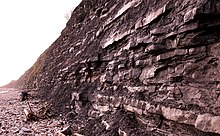
Influence of astronomical cycles
[edit]In many cases facies changes and other lithological features in sequences of sedimentary rock have a cyclic nature. This cyclic nature was caused by cyclic changes in sediment supply and the sedimentary environment. Most of these cyclic changes are caused by astronomic cycles. Short astronomic cycles can be the difference between the tides or the spring tide every two weeks. On a larger time-scale, cyclic changes in climate and sea level are caused by Milankovitch cycles: cyclic changes in the orientation and/or position of the Earth's rotational axis and orbit around the Sun. There are a number of Milankovitch cycles known, lasting between 10,000 and 200,000 years.[39]
Relatively small changes in the orientation of the Earth's axis or length of the seasons can be a major influence on the Earth's climate. An example are the ice ages of the past 2.6 million years (the Quaternary period), which are assumed to have been caused by astronomic cycles.[40] Climate change can influence the global sea level (and thus the amount of accommodation space in sedimentary basins) and sediment supply from a certain region. Eventually, small changes in astronomic parameters can cause large changes in sedimentary environment and sedimentation.
Sedimentation rates
[edit]The rate at which sediment is deposited differs depending on the location. A channel in a tidal flat can see the deposition of a few metres of sediment in one day, while on the deep ocean floor each year only a few millimetres of sediment accumulate. A distinction can be made between normal sedimentation and sedimentation caused by catastrophic processes. The latter category includes all kinds of sudden exceptional processes like mass movements, rock slides or flooding. Catastrophic processes can see the sudden deposition of a large amount of sediment at once. In some sedimentary environments, most of the total column of sedimentary rock was formed by catastrophic processes, even though the environment is usually a quiet place. Other sedimentary environments are dominated by normal, ongoing sedimentation.[41]
In some sedimentary environments, sedimentation only occurs in some places. In a desert, for example, the wind deposits siliciclastic material (sand or silt) in some spots, or catastrophic flooding of a wadi may cause sudden deposis of large quantities of detrital material, but in most places eolian erosion dominates. The amount of sedimentary rock that forms is not only dependent on the amount of supplied material, but also on how well the material consolidates. Erosion removes most deposited sediment shortly after deposition.[41]
Stratigraphy
[edit]
That new rock layers are above older rock layers is stated in the principle of superposition. There are usually some gaps in the sequence called unconformities. These represent periods where no new sediments were laid down, or when earlier sedimentary layers raised above sea level and eroded away.
Sedimentary rocks contain important information about the history of the Earth. They contain fossils, the preserved remains of ancient plants and animals. Coal is considered a type of sedimentary rock. The composition of sediments provides us with clues as to the original rock. Differences between successive layers indicate changes to the environment over time. Sedimentary rocks can contain fossils because, unlike most igneous and metamorphic rocks, they form at temperatures and pressures that do not destroy fossil remains.
See also
[edit]- Back-stripping
- Deposition (geology)
- Dunham classification
- erosion
- List of minerals
- List of rock types
- Sediment transport
External links
[edit]References
[edit]- ^ a b Dott, R. H, (1964). Wacke, graywacke and matrix - what approach to immature sandstone classification: Journal of Sedimentary Petrology, v-34, p. 625-632
- ^ a b Blatt, H., Middleton, G and Murray, R., 1980: Origin of Sedimentary Rocks. Prentice Hill, 782 p.
- ^ a b c Prothero, D.R. and Schwab, F., 2004, Sedimentary Geology (2nd ed.), Freeman, New York, 557 p
- ^ a b Boggs, S., 2006, Principles of Sedimentology and Stratigraphy (4th ed.), Pearson Prentice Hall, Upper Saddle River, NJ, 662 p.
- ^ Stow, D., 2005, Sedimentary rocks in the field. Burlington, MA: Academic Press.
- ^ Levin (1987), p 57
- ^ Tarbuck & Lutgens (1999), pp 145-146; Levin (1987) p 57
- ^ Boggs (1987), p 105
- ^ Tarbuck & Lutgens (1999), pp 156-157; Levin (1987), p 58
- ^ Boggs (1987), pp 112-115; Blatt et al. (1980), pp 55-58
- ^ Levin (1987), p 60; Blatt et al. (1980), pp 75-80
- ^ Folk (1965), p 62
- ^ See Folk (1965), pp 62-64 for an overview of major minerals in siliciclastic rocks and their relative stabilities
- ^ Stanley (1999), p 60-61
- ^ Levin (1987), p 92; Stanley (1999), p 61
- ^ Levin (1987), pp 92-93
- ^ Tarbuck & Lutgens (1999), pp 160-161; Press et al. (2003), p 171
- ^ Boggs (1987), p 138
- ^ For descriptions of cross-bedding, see Blatt et al. (1980), p 128, pp 135-136; Press et al. (2003), pp 171-172
- ^ Blatt et al. (1980), pp 133-135
- ^ For an explanation about graded bedding, see Boggs (1987), pp 143-144; Tarbuck & Lutgens (1999), p 161; Press et al. (2003), p 172
- ^ Collinson et al. (2006), pp 46-52; Blatt et al. (1980), pp 155-157
- ^ Tarbuck & Lutgens, p 162; Levin (1987), p 62; Blatt et al. (1980), pp 136-154
- ^ See Stanley (1999), p 62; Levin (1987), pp 93-95; Collinson et al. (2006), pp 216-232 for a short description of trace fossils
- ^ Collinson et al. (2006), p 215
- ^ See for concretions Collinson et al. (2006), pp 206-215
- ^ Collinson et al. (2006), pp 183-185
- ^ Collinson et al. (2006), pp 193-194
- ^ Collinson et al. (2006), pp 202-203
- ^ See Press et al. (2003) or Einsele (2000), part II for an overview of different sedimentary environments
- ^ See Levin (2003), p 63 for a definition of shallow marine environments
- ^ Tarbuck & Lutgens (1999), pp 452-453
- ^ See Levin (2003), p 67-68 for an overview over continental environments
- ^ Tarbuck & Lutgens (1999), pp 158-160
- ^ Reading (1996), pp 19-20
- ^ Reading (1996), pp 20-21
- ^ For an overview over facies shifts and the relations in the sedimentary rock record by which they can be recognized, see Reading (1996), pp 22-33
- ^ See for an overview of sedimentary basin types: Press et al. (2003), pp 187-189; Einsele (2000), pp 3-9
- ^ See for a short explanation of Milankovitch cycles Tarbuck & Lutgens (1999), pp 322-323; Reading (1996), pp 14-15
- ^ Stanley (1999), p 536; Andersen & Borns (1994), pp 29-32
- ^ a b Reading (1996), p 17
{{DEFAULTSORT:Sedimentary Rock}} [[Category:Petrology]] [[Category:Sedimentary rocks| ]] {{Link FA|sk}}
